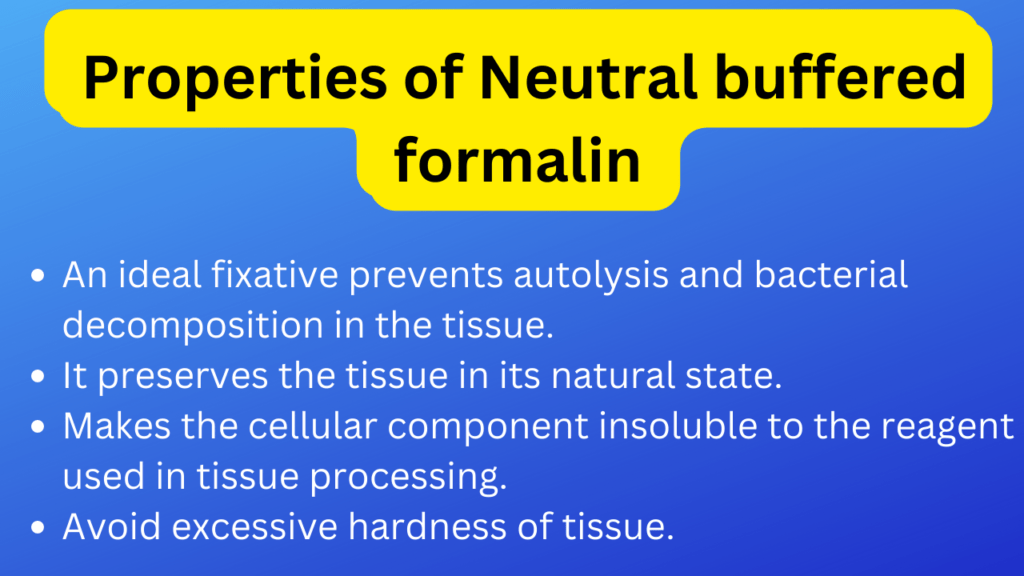10% Neutral Buffered Formalin is widely used in labs for preserving biological tissues. It stabilizes tissue structures by cross-linking proteins, and the buffer system ensures a neutral pH, which helps reduce tissue damage during fixation.
Here’s the composition of 1 liter of 10% Neutral Buffered Formalin:
- Formaldehyde solution (37-40% concentration): 100 mL
- Distilled water: 900 mL
- Sodium dihydrogen phosphate (NaH₂PO₄, monobasic): 4 g
- Disodium hydrogen phosphate (Na₂HPO₄, dibasic): 6.5 g
How to prepare 1 liter 10% neutral buffered formalin at laboratory
- Start by measuring 100 mL of 37-40% formaldehyde and mix it with 900 mL of distilled water.
- Add 4 grams of sodium dihydrogen phosphate (monobasic) and 6.5 grams of disodium hydrogen phosphate (dibasic) to the formaldehyde-water mixture.
- Stir the solution well until both phosphate salts are fully dissolved.
- Check the pH of the solution, ensuring it’s close to 7.0, which ensures that the solution is neutral and ready for use.
This solution is called “10% formalin” because it contains 10% formaldehyde by volume, but it’s buffered to maintain an optimal environment for tissue preservation.
What are the properties of neutral buffered formalin?
An ideal fixative prevents autolysis and bacterial decomposition in the tissue.- It preserves the tissue in its natural state.
- Fix all tissue components at their position.
- Makes the cellular component insoluble to the reagent used in tissue processing.
- Preserve the tissue volume.
- Avoid excessive hardness of tissue.
- Enhance tissue staining(H and E stain) process.
- It should be non-toxic and non-allergic to the user.
- Good fixative should be cheap.
Classification of chemical fixatives in the Histopathology laboratory
Fixatives are classified into three groups.
- Tissue fixatives
- Histochemical fixatives
- Cytology fixatives
What are the tissue fixative examples?
These fixatives are specially used for tissue fixation. Following fixatives used for tissue
- Buffered Formal saline
- Zenker Solution
- Buffered Glutaraldehyde
What are Histochemical fixative names?
These fixatives are specially used for histochemical fixation. Following fixatives used
- Cold acetone
- Absolute Alcohol
- Formal Saline
Types of cytological fixatives and examples
These fixatives are used for cytological specimens. Following fixatives used in the cytology
- Ether
- Methanol
- Ethanol
10 most common types of fixative used in Histopathology
Two fixatives are commonly used
- 10% Routine Formalin
- 10% Buffered Formalin
- Ethyl Alcohol
- Mercuric Chloride
- Picric Acid
- Chromic Acid
- Potassium Dichromate
- Osmic Acid (Osmium Tetra Oxide)
- B-5 Fixative
- Zinker Solution
5 Properties of 10% routine formalin histopathology
- It is prepared with a 40% w/w solution of formaldehyde gas in water.
- Routine formalin is used at 10% or 15% V/V in normal saline or calcium chloride solution.
- It does not precipitate PROTEIN. But combine with NH2 to form an insoluble gel.
- Preserves all components including fats. Phospholipid insoluble in fat solvents.
- Cheapest and most popular fixative in histology.
What is the disadvantage of 10% routine formalin fixative?
Routine formalin has acidic PH. This results in haematin crystal formation during fixation. These crystals also affect tissue staining(Hematoxylin and eosin).
6 Advantages of 10% neutral buffered formalin fixative
Following are the uses or advantages of a 10 percent neutral buffer
- Tissue can be preserved in it for a longer time.
- There is no hardening of the tissue.
- Tissue sectioning is easy.
- No haematin crystal is formed.
- It enhances tissue staining.
- A number of stains can be used on such preserved tissue.
Fixative of choice and Target table (Do, don’t)
The following fixatives are used as a fixative of choice for protein, lipid, and enzyme.
| Fixative of choice | Target | To be avoided |
| Frozen section | Enzyme | Chemical fixative |
| Buffered formalin | Protein | Osmium tetraoxide |
| Alcohol fixative | Nucleic acid | Aldehyde Fixative |
| Alcohol-based fixative | Glycogen | Osmium tetraoxide |
| Frozen section | Lipid | Alcohol, formalin |
| Frozen Section | Mucopolysaccharide | Chemical Fixative |
